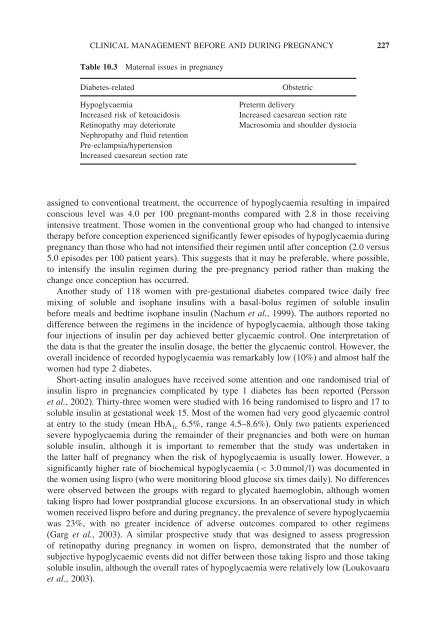Hypoglycaemia in Clinical Diabetes
Hypoglycaemia in Clinical Diabetes
Hypoglycaemia in Clinical Diabetes
- No tags were found...
Create successful ePaper yourself
Turn your PDF publications into a flip-book with our unique Google optimized e-Paper software.
CLINICAL MANAGEMENT BEFORE AND DURING PREGNANCY 227Table 10.3Maternal issues <strong>in</strong> pregnancy<strong>Diabetes</strong>-related<strong>Hypoglycaemia</strong>Increased risk of ketoacidosisRet<strong>in</strong>opathy may deteriorateNephropathy and fluid retentionPre-eclampsia/hypertensionIncreased caesarean section rateObstetricPreterm deliveryIncreased caesarean section rateMacrosomia and shoulder dystociaassigned to conventional treatment, the occurrence of hypoglycaemia result<strong>in</strong>g <strong>in</strong> impairedconscious level was 4.0 per 100 pregnant-months compared with 2.8 <strong>in</strong> those receiv<strong>in</strong>g<strong>in</strong>tensive treatment. Those women <strong>in</strong> the conventional group who had changed to <strong>in</strong>tensivetherapy before conception experienced significantly fewer episodes of hypoglycaemia dur<strong>in</strong>gpregnancy than those who had not <strong>in</strong>tensified their regimen until after conception (2.0 versus5.0 episodes per 100 patient years). This suggests that it may be preferable, where possible,to <strong>in</strong>tensify the <strong>in</strong>sul<strong>in</strong> regimen dur<strong>in</strong>g the pre-pregnancy period rather than mak<strong>in</strong>g thechange once conception has occurred.Another study of 118 women with pre-gestational diabetes compared twice daily freemix<strong>in</strong>g of soluble and isophane <strong>in</strong>sul<strong>in</strong>s with a basal-bolus regimen of soluble <strong>in</strong>sul<strong>in</strong>before meals and bedtime isophane <strong>in</strong>sul<strong>in</strong> (Nachum et al., 1999). The authors reported nodifference between the regimens <strong>in</strong> the <strong>in</strong>cidence of hypoglycaemia, although those tak<strong>in</strong>gfour <strong>in</strong>jections of <strong>in</strong>sul<strong>in</strong> per day achieved better glycaemic control. One <strong>in</strong>terpretation ofthe data is that the greater the <strong>in</strong>sul<strong>in</strong> dosage, the better the glycaemic control. However, theoverall <strong>in</strong>cidence of recorded hypoglycaemia was remarkably low (10%) and almost half thewomen had type 2 diabetes.Short-act<strong>in</strong>g <strong>in</strong>sul<strong>in</strong> analogues have received some attention and one randomised trial of<strong>in</strong>sul<strong>in</strong> lispro <strong>in</strong> pregnancies complicated by type 1 diabetes has been reported (Perssonet al., 2002). Thirty-three women were studied with 16 be<strong>in</strong>g randomised to lispro and 17 tosoluble <strong>in</strong>sul<strong>in</strong> at gestational week 15. Most of the women had very good glycaemic controlat entry to the study (mean HbA 1c 6.5%, range 4.5–8.6%). Only two patients experiencedsevere hypoglycaemia dur<strong>in</strong>g the rema<strong>in</strong>der of their pregnancies and both were on humansoluble <strong>in</strong>sul<strong>in</strong>, although it is important to remember that the study was undertaken <strong>in</strong>the latter half of pregnancy when the risk of hypoglycaemia is usually lower. However, asignificantly higher rate of biochemical hypoglycaemia (< 30 mmol/l) was documented <strong>in</strong>the women us<strong>in</strong>g lispro (who were monitor<strong>in</strong>g blood glucose six times daily). No differenceswere observed between the groups with regard to glycated haemoglob<strong>in</strong>, although womentak<strong>in</strong>g lispro had lower postprandial glucose excursions. In an observational study <strong>in</strong> whichwomen received lispro before and dur<strong>in</strong>g pregnancy, the prevalence of severe hypoglycaemiawas 23%, with no greater <strong>in</strong>cidence of adverse outcomes compared to other regimens(Garg et al., 2003). A similar prospective study that was designed to assess progressionof ret<strong>in</strong>opathy dur<strong>in</strong>g pregnancy <strong>in</strong> women on lispro, demonstrated that the number ofsubjective hypoglycaemic events did not differ between those tak<strong>in</strong>g lispro and those tak<strong>in</strong>gsoluble <strong>in</strong>sul<strong>in</strong>, although the overall rates of hypoglycaemia were relatively low (Loukovaaraet al., 2003).
















